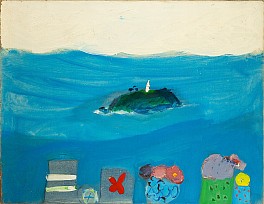BIOGRAPHY

German-American (1919-2011)
Edith Schloss ws a German-Jewish-American artist known for her assemblages and, later in her career, her paintings of the beach, the sea, birds, flowers and other bric-a-brac. Her paintings were of modest scale and conved the bleached out whitened feeling of a very sunny sky and sand. Schloss was also an art critic of note and the posthumous author of "The Loft Generation: From the De Koonings to Twombley."
Schloss was born in Offenbach, Germany to a prosperous Jewish family who encouraged her artistic interests. Forced to flee the Nazis in 1936, Schloss traveled to Italy and Great Britain before she landed on American shores as a stateless refugee. In New York, she studied at the Cooper Union, the New School and the Art Students League. By 1944, she was living in Chelsea and fell in with the De Koonings, Jane Freilicher, Nell Blaine and others. She became particularly close to Fairfield Porter. She began to show fairly quickly, including at the Tanager Gallery, the Jane Street Artists Collective, Poindexter Gallery, Ingber Gallery and others.
In 1962, upon the dissolution of her marriage, Schloss moved to Rome where she would spend her next 50 years. There she would develop her signature style. Her vivid animated still lifes, filled with poised objects as characters evoke the paintings of Matisse, Philip Guston, Avery, Fairfield Porter, and Arthur Dove among the many. But most of all, it was Morandi (“one of the few painters who knew how to fuse sentiment with intelligence, who said a lot with few means,” she wrote), and de Kooning, who stood out as kings for her. It was “the tangy taste of Mediterranean color that cut into your senses, to stay there forever,” she said of de Kooning’s early paintings.
Schloss was a colorist through and through. Her works were composed with bright, joyful, exuberant, sometimes jarring color. You got the feeling she lived color. “A color,” she remarked apropos of Cy Twombly’s “pungent … but thirst-stilling green … assaults a painter like an emotion, like a food. It’s visceral. The shock brings you delight and despair: red, the squeezed blood of murder or sacrifice or ripe grapes. Green, like the still pond with moss ferns or worms in its depth; violet in waves violently choking abandoned lovers; yellow, running pus or sinking summer sun. It’s a taste, leaving something new and full inside you."
Schloss was a woman in a man's world. This fact and her expatriate status were the two chief reasons she is not better known today. She decried the diminution of women in the “what the fuck man’s land” of the New York art scene in the 1950s, and later the difficulty of being taken seriously as an artist while earning a living as an art writer and critic. At the same time, to be fair and like many of her female compatriates, it was to the men she looked for inspiration and guidance, not women.
It is important to say that her paintings are not "girlie" or merely "pretty." Her message was transitoriness. Her approach to painting broadly resembled John Ford’s way of making movies. Both adopted a fixed vantage – no tracking or panning – in which a few tableaux could play out, with the eye trained on the horizon. For Ford, that area tended to be a Western plateau; he famously favored shooting in Monument Valley, on the Arizona–Utah border. For Schloss, it was an intimate segment of beach, water and sometimes sky seen from a window. Both valued a consistent mise-en-scène through which the world as it proceeded could be reliably observed, recorded, and remembered before it was forgotten or disappeared
Her work is in the collection of the Metropolitan Museum of Art, among others.
